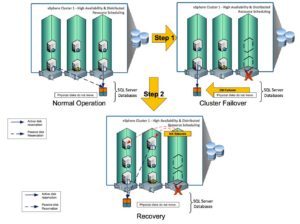Running Microsoft SQL Server on VMware vSphere offers many options for database availability and disaster recovery utilizing the best features from both VMware and Microsoft. For example, VMware vSphere vMotion and VMware vSphere Distributed Resource Scheduler (DRS) can help to reduce planned downtime and balance workloads dynamically, and VMware vSphere High Availability (HA) can help to recover SQL Server databases in the case of host failure.
At the application level, all SQL Server features and techniques are supported on vSphere, including AlwaysOn Availability Groups, AlwaysOn Failover Cluster Instances, database mirroring, and log shipping. SQL Server availability features can be used inside of a virtual machine just as you would on a physical server, and combined with vSphere features to support flexible availability and recovery
scenarios, applying the most efficient and appropriate tools for different use cases.
AlwaysOn is a collection of high availability and disaster recovery features introduced in SQL Server 2012 that minimize Recovery Point Objective (RPO) and Recovery Time Objective (RTO), and maximize availability of databases. SQL Server AlwaysOn branding encompasses both FCIs and AGs. The following table lists SQL Server availability options and their ability to meet RTOs and RPOs. Before choosing any option, evaluate your business requirements to determine which ones best meet your specific needs.
Download this new technical white paper Microsoft SQL Server on VMware vSphere Availability and Recovery Options


